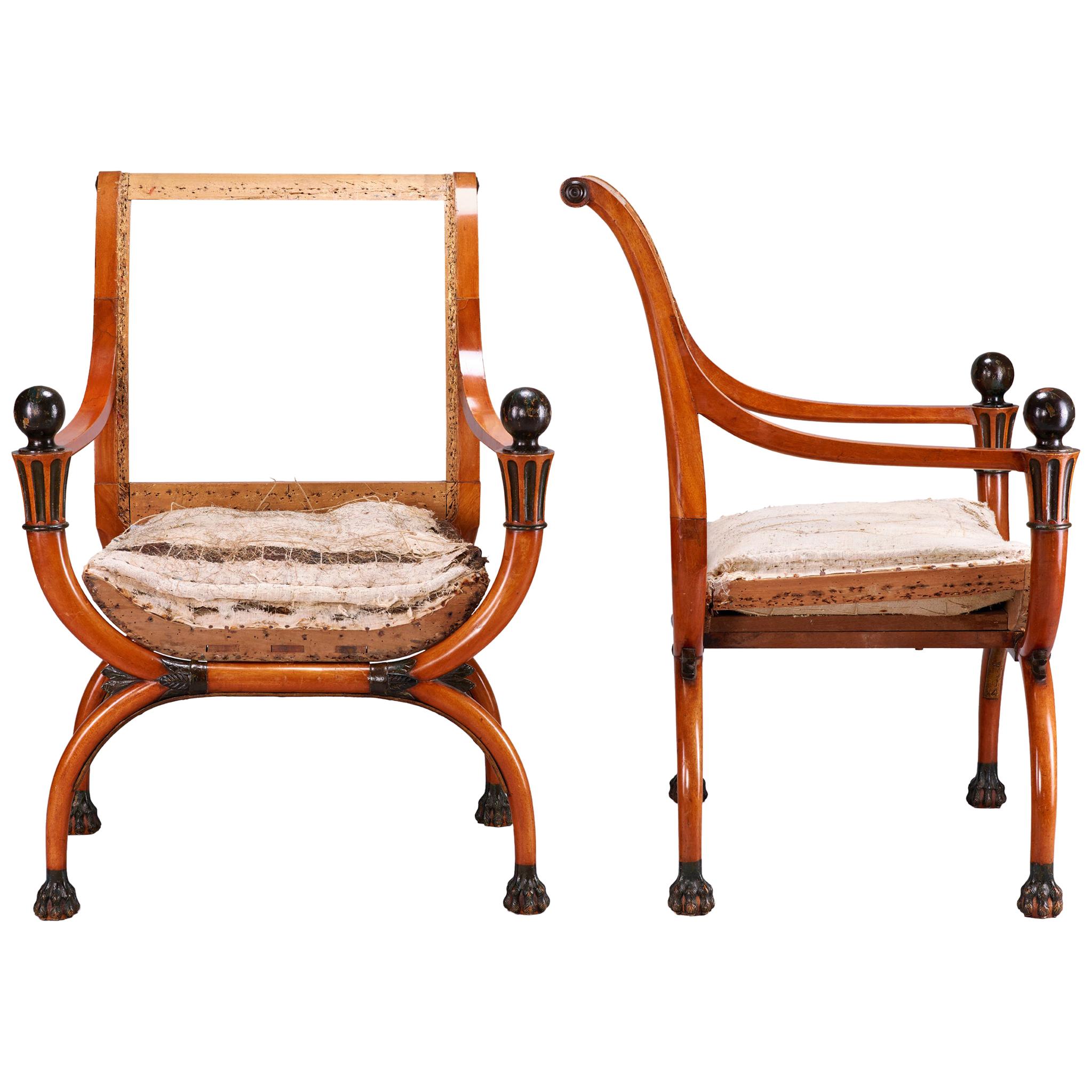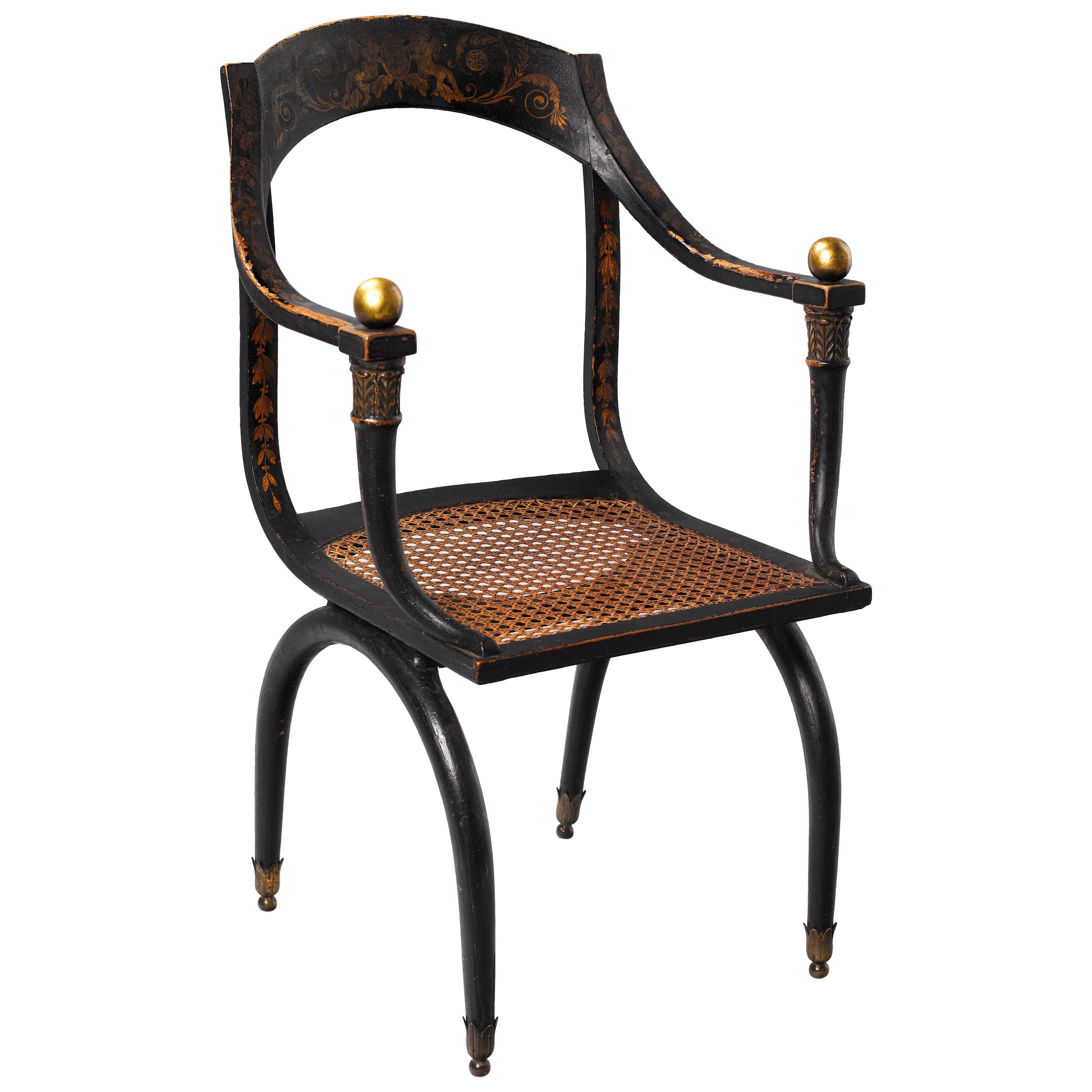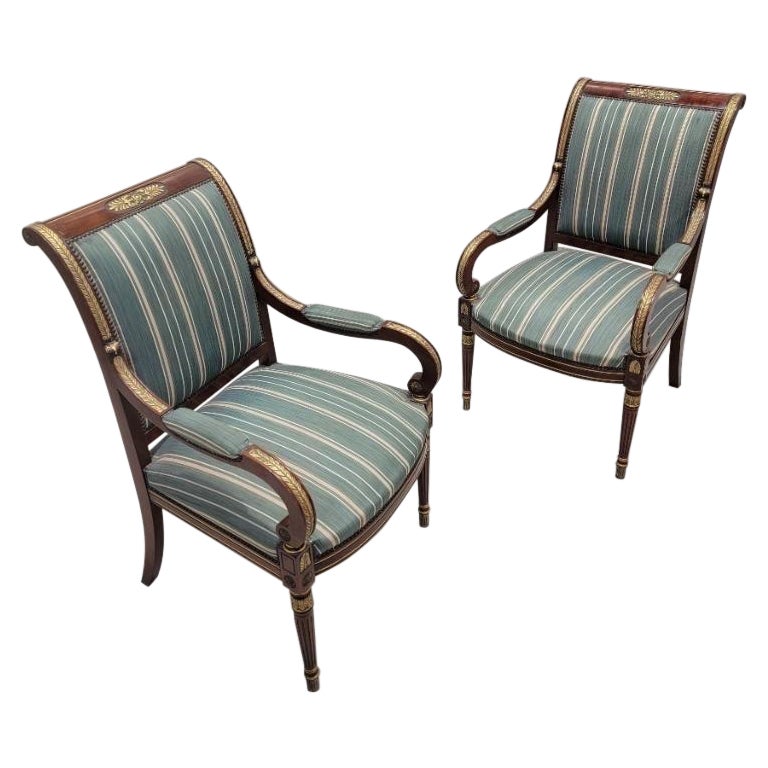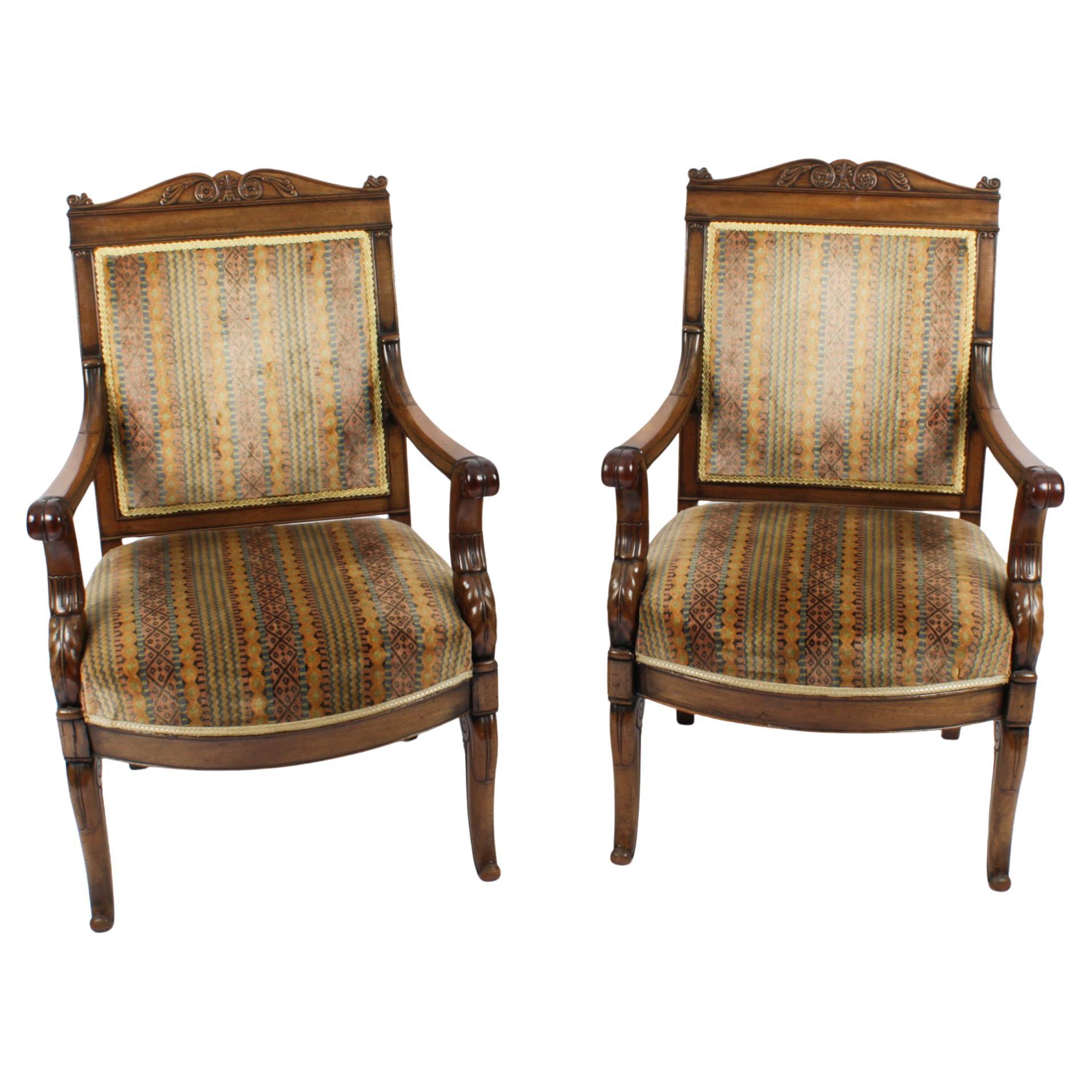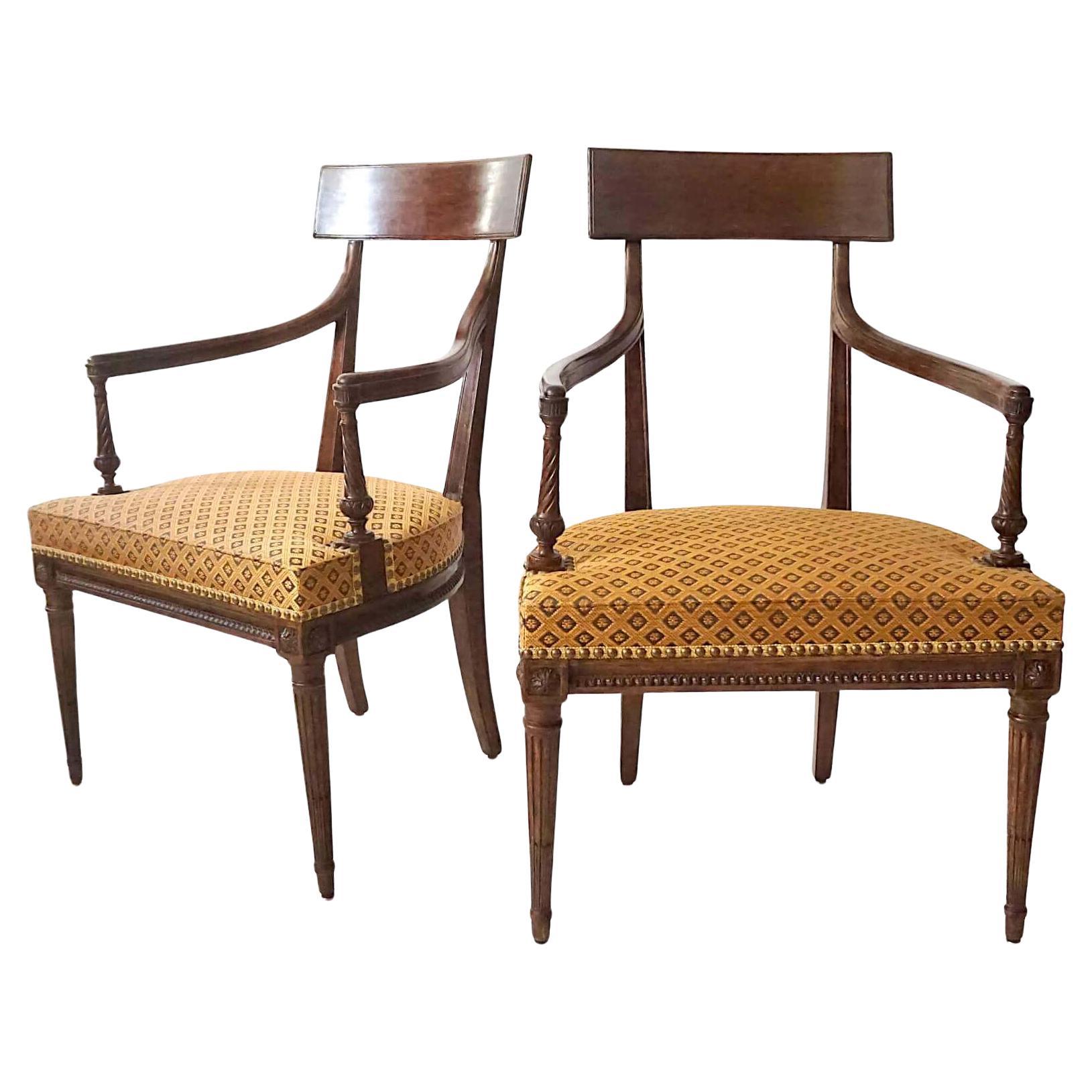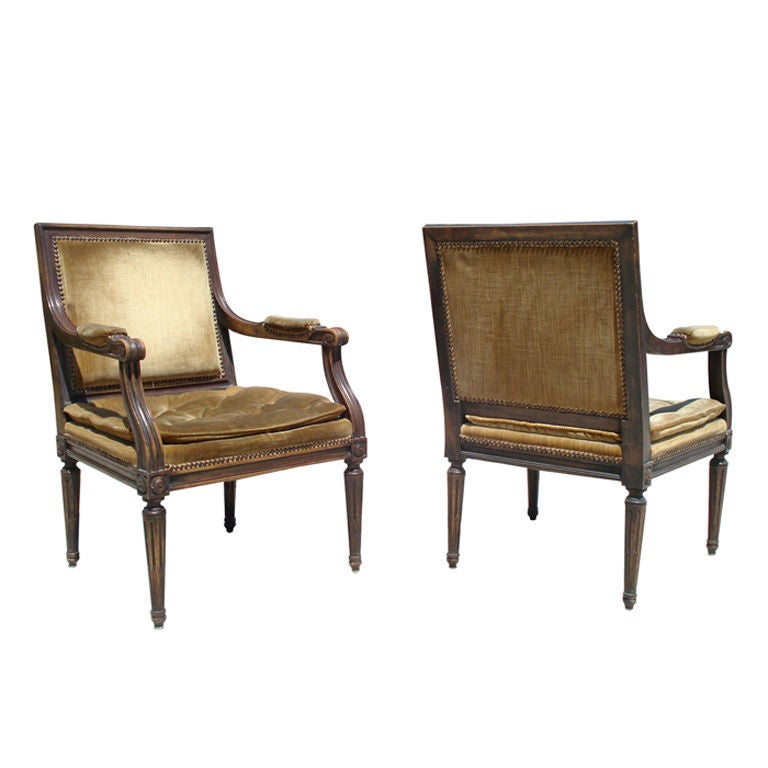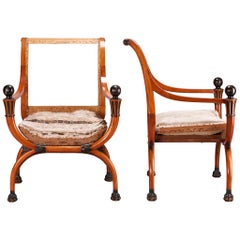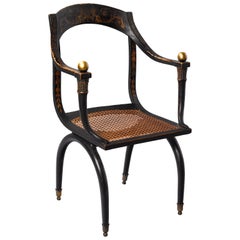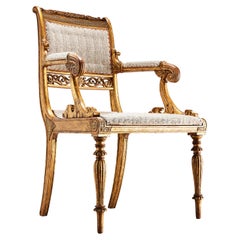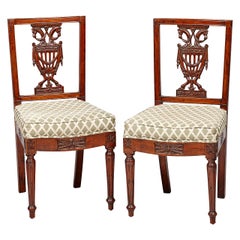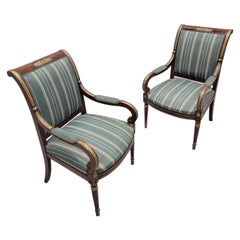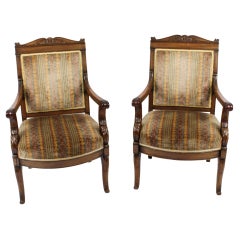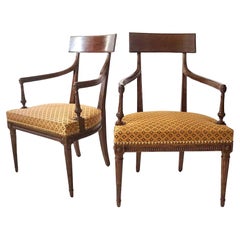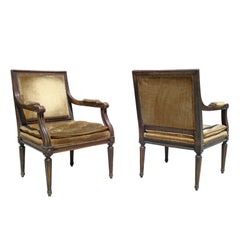Items Similar to Jean-Joseph Chapuis Rare Pair of Empire parcel-gilt japanned Fauteuils
Want more images or videos?
Request additional images or videos from the seller
1 of 6
Jean-Joseph Chapuis Rare Pair of Empire parcel-gilt japanned Fauteuils
$59,937.52per set
£44,525.19per set
€50,000per set
CA$83,230.14per set
A$90,823.39per set
CHF 47,638.40per set
MX$1,103,080.36per set
NOK 595,029.77per set
SEK 562,332.89per set
DKK 380,644.75per set
About the Item
Despite his long life, very little is known about the general production of menuisier (chairmaker) Jean-Joseph Chapuis and even less about his use of bent laminates, which must be viewed as the most advanced of its kind until the appearance of Michael Thonet’s work of the 1830s.
The profound reverence for the classical world in enlightened circles in early nine-teenth-century Europe and the United States often resulted in the archaeological resurrection of the art, architecture, and design of ancient Greece and Rome. No chair employing the innovative technique of bending wood more boldly expresses this allegiance to the past than this armchair painted in le style antique and based on the ancient Roman sella curulis (folding stool); With a curved toprail decorated with putti supporting a medaillion and flanked by scrolling acanthus, the arms with ball finials, above a caned seat, on curved supports terminating in foliate gilt-metal sabots. This merger of technological innovation with fashionable aesthetics parallels the work of the American Samuel Gragg who used a bent-wood methodology to produce his body of chairs based on the ancient Greek klismos chair .
Dramatic curves such as the inverted U form of the two pairs of legs and the sweeping curve of the continuous back and seat rail cannot be made by carving solid wood as the resulting element would be too weak to be practical. These curves could only be produced by bent laminated wood. A series of four to five solid wooden rods, each a quarter of an inch thick, were glued together, bent, bound in a caul (mold), dried, and then shaped to the appropriate form with a rasp. Jean-Joseph Chapuis was one of the first chairmakers to use the innovative technique of laminated wood to create such exaggerated curves. This technique was taken up and fully exploited by Michael Thonet after 1830. In the second half of the 19th century bentwood furniture became highly popular.
Identical models of this fauteuil were among the furnishings of the Royal Palace at Laeken, near Brussels, during the early years of the Napoleonic occupation. As a result, the maker of this chair was thought to have been the Parisian ébéniste Claude Chapuis, but Denise Ledoux-Lebard has proved that Jean-Joseph Chapuis of Brussels was in fact responsible for this design. The models installed at Laeken are painted white (see illustration below).
This is a very rare and attractive pair of museums quality and condition. An iconic chair from one of the most talented and celebrated cabinetmakers of the time.
- Creator:Jean Joseph Chapuis (Cabinetmaker)
- Dimensions:Height: 35.04 in (89 cm)Width: 21.66 in (55 cm)Depth: 21.66 in (55 cm)Seat Height: 16.54 in (42 cm)
- Sold As:Set of 2
- Style:Empire (Of the Period)
- Materials and Techniques:
- Place of Origin:
- Period:
- Date of Manufacture:circa 1805
- Condition:Wear consistent with age and use. very minor retouches to the painted surface.
- Seller Location:Worpswede / Bremen, DE
- Reference Number:Seller: 34521stDibs: LU981439917242
About the Seller
5.0
Recognized Seller
These prestigious sellers are industry leaders and represent the highest echelon for item quality and design.
Established in 1979
1stDibs seller since 2013
27 sales on 1stDibs
Typical response time: 23 hours
- ShippingRetrieving quote...Shipping from: Worpswede / Bremen, Germany
- Return Policy
Authenticity Guarantee
In the unlikely event there’s an issue with an item’s authenticity, contact us within 1 year for a full refund. DetailsMoney-Back Guarantee
If your item is not as described, is damaged in transit, or does not arrive, contact us within 7 days for a full refund. Details24-Hour Cancellation
You have a 24-hour grace period in which to reconsider your purchase, with no questions asked.Vetted Professional Sellers
Our world-class sellers must adhere to strict standards for service and quality, maintaining the integrity of our listings.Price-Match Guarantee
If you find that a seller listed the same item for a lower price elsewhere, we’ll match it.Trusted Global Delivery
Our best-in-class carrier network provides specialized shipping options worldwide, including custom delivery.More From This Seller
View AllRare Pair of French Directoire Fauteuils en Curule, Paris, circa 1800, G. Jacob
By Georges Jacob
Located in Worpswede / Bremen, DE
These finely sculpted fauteuils supported by curule-form bases, reflect the 'antique' influence of the excavations at Pompeii and Herculaneum during the 18th century. This form based on the antique Roman sella...
Category
Antique Early 19th Century French Neoclassical Armchairs
Materials
Mahogany
Important Empire Early 19th Century Fauteuil by Jean-Joseph Chapuis
By Jean Joseph Chapuis
Located in Worpswede / Bremen, DE
Despite his long life, very little is known about the general production of menuisier (chairmaker) Jean-Joseph Chapuis (1765-1864) and even less about his use of bent laminates, which must be viewed as the most advanced of its kind until the appearance of Michael Thonet’s work of the 1830s.
The profound reverence for the classical world in enlightened circles in early 19th century Europe and the United States often resulted in the archaeological resurrection of the art, architecture, and design of ancient Greece and Rome. No chair employing the innovative technique of bending wood more boldly expresses this allegiance to the past than this armchair painted in le style antique and based on the ancient Roman sella...
Category
Antique Early 19th Century Belgian Empire Armchairs
Materials
Cane, Bentwood
Early 19th Century Danish Giltwood Armchair by Gustav Friederich Hetsch
Located in Worpswede / Bremen, DE
A very decorative and large giltwood armchair after a design by the famous Danish Architect Gustav Friedrich Hetsch, (1788-1964). The German bo...
Category
Antique Early 19th Century Danish Empire Armchairs
Materials
Giltwood
Pair of Royal Late 18th Century Neoclassical Berlin Side Chairs
Located in Worpswede / Bremen, DE
The finely carved unusual splat with two horse heads in the centre holding draperies in their mouth above a classcial pierced splat decorated with further draperies and supported by ...
Category
Antique Late 18th Century German Neoclassical Side Chairs
Materials
Wood
Neoclassical Empire Early 19th Century Mahogany Desk Armchair
Located in Worpswede / Bremen, DE
An unusual North European mahogany desk armchair with original brass castors. Fully carved armrests with eagle heads, the design probably by a designer from Berlin or Copenhagen (e.g...
Category
Antique Early 19th Century German Empire Armchairs
Materials
Brass
Unusual Early 19th Century Danish Mahogany Armchair Attributed to Hetsch
Located in Worpswede / Bremen, DE
This chair is of highly elaborate design and exceptional craftsmanship. Open arms enclosing ornamental stylized foliage. Pierced turned reeded front legs, drop in seat and padded bac...
Category
Antique Mid-19th Century Danish Romantic Armchairs
Materials
Mahogany
You May Also Like
Antique French Empire Mahogany and Gilt Bronze Mounted Armchairs - Pair
Located in Chicago, IL
Antique French Empire Mahogany and Gilt Bronze Mounted Armchair in Blue Patterned Stripped Silk Blent - Pair
This Antique French Empire armchair...
Category
Antique 19th Century French Empire Side Chairs
Materials
Silk, Upholstery, Mahogany
Antique Pair French Empire Armchair Fauteuils Chairs, 19th Century
Located in London, GB
This is an elegant antique pair of French Empire Revival upholstered back mahogany armchair fauteuils, circa 1880 in date.
The mahogany is beautiful in colour with superb patina. Th...
Category
Antique 1880s French Empire Armchairs
Materials
Mahogany
Louis XVI Neoclassical Fauteuils Attributed to Georges Jacob, Pair, circa 1785
By Georges Jacob
Located in Kinderhook, NY
A fine pair of French, circa 1785, late Louis XVI fauteuils having tall tablet form backrests on channeled vertical supports issuing shaped arms ending in 'dolphin-nose' arm-rests ab...
Category
Antique Late 18th Century French Louis XVI Armchairs
Materials
Brass
Pair of Louis XVI Style Fauteuil
Located in Palm Springs, CA
Pair of good Louis XVI style fauteuil with original bronze velvet upholstery and nailhead trim. Nice carving, good proportions. Seat cushion is button tufted and semi-attached.
Category
20th Century French Armchairs
Materials
Wood
$3,880 Sale Price / set
20% Off
Pair of French Empire Mahogany and Gilt Bronze Mounted Armchairs
Located in Vancouver, British Columbia
A striking pair of late French Empire mahogany armchairs, highly decorated with gilded bronze mounts on the upper back rail and all round the bottom of the seat as well. The curved open front arms terminate in carved dolphins. The chairs have been re-upholsterd in a cream and dark green striped antique silk fabric...
Category
Antique Mid-19th Century French Empire Armchairs
Materials
Silk, Mahogany
$5,600 Sale Price
30% Off
Antique Pair French Empire Revival Ormolu Mounted Armchairs 19th Century
Located in London, GB
This is a fantastic and highly decorative antique pair of French gilt bronze mounted Empire Revival fauteuil armchairs, circa 1870 in date.
They have been crafted from fabulous sol...
Category
Antique 1870s French Empire Revival Armchairs
Materials
Mahogany
More Ways To Browse
Bent Lamination
Antique Klismos Chair
Ancient Stool
Roman Sella
Paimio 41
Pair Theodore Alexander Chairs
Parzinger Campaign Chair
Pierre Jeanneret Easy Low Chairs
Pierre Jeanneret Floating Back
Pineapple Armchairs
Pizzetti Roma
Poltrona Frau Dezza
Poltrona Frau Vintage
Poltrona Munari
Potty Chair
Quartz Armchair
Quebec 69
Regent Armchair
